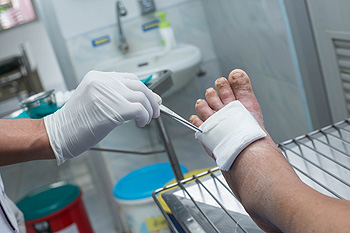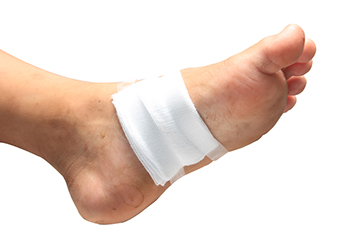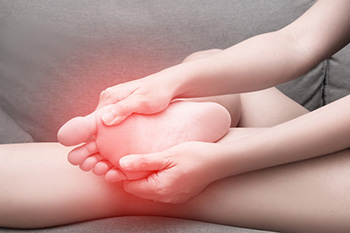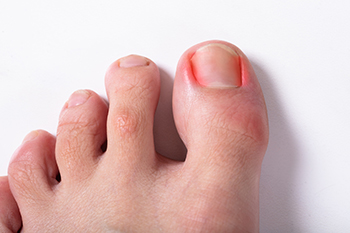Connect With Us
Blog
Items filtered by date: September 2025
Diabetic Wound Care Can Help Prevent Serious Complications

Diabetic wounds, especially on the feet, are a serious concern for individuals with diabetes, due to poor circulation and reduced sensation. These wounds may begin as small cuts, blisters, or pressure sores and can quickly develop into ulcers if not properly treated. They may appear red and swollen, or drain fluid, but may not be painful due to nerve damage. Common causes include high blood sugar levels, poor foot hygiene, ill-fitting shoes, and unnoticed injuries. A podiatrist plays a vital role in diabetic wound care by diagnosing the severity of the wound through physical examination and, when needed, imaging or lab tests. Treatments may include wound cleaning, debridement, pressure offloading, and advanced wound dressings. A podiatrist also provides education on proper foot care and prevention strategies to reduce the risk of future wounds. If you notice signs of a foot wound, it is suggested that you make an appointment with a podiatrist immediately to avoid serious complications.
Diabetic foot care is important in preventing foot ailments such as ulcers. If you are suffering from diabetes or have any other concerns about your feet, contact Steven Ginex, DPM from Palm Desert Podiatry. Our doctor can provide the care you need to keep you pain-free and on your feet.
Diabetic Foot Care
Diabetes affects millions of people every year. The condition can damage blood vessels in many parts of the body, especially the feet. Because of this, taking care of your feet is essential if you have diabetes, and having a podiatrist help monitor your foot health is highly recommended.
The Importance of Caring for Your Feet
- Routinely inspect your feet for bruises or sores.
- Wear socks that fit your feet comfortably.
- Wear comfortable shoes that provide adequate support.
Patients with diabetes should have their doctor monitor their blood levels, as blood sugar levels play such a huge role in diabetic care. Monitoring these levels on a regular basis is highly advised.
It is always best to inform your healthcare professional of any concerns you may have regarding your feet, especially for diabetic patients. Early treatment and routine foot examinations are keys to maintaining proper health, especially because severe complications can arise if proper treatment is not applied.
If you have any questions, please feel free to contact our office located in Palm Desert, CA . We offer the newest diagnostic and treatment technologies for all your foot care needs.
Approaches for Healing Complex Diabetic Foot Wounds

Diabetic foot wounds can be stubborn and difficult to heal, often requiring more than standard dressings and rest. Advances in care have introduced therapies that improve circulation, encourage new tissue growth, and reduce infection risk. Hyperbaric oxygen therapy is one option that supplies extra oxygen to the tissues, helping speed up repair. Negative pressure wound therapy uses gentle suction to remove fluids and promote blood flow. Skin substitutes and growth factor treatments can also stimulate healing when traditional methods fall short. Each therapy is chosen based on the severity of the wound and the overall health of the patient. The goal is always to restore mobility, prevent infection, and avoid complications that could lead to surgery. If you are living with a complex diabetic foot wound, it is suggested that you schedule a visit with a podiatrist to discuss the best treatment plan for you.
Wound care is an important part in dealing with diabetes. If you have diabetes and a foot wound or would like more information about wound care for diabetics, consult with Steven Ginex, DPM from Palm Desert Podiatry. Our doctor will assess your condition and provide you with quality foot and ankle treatment.
What Is Wound Care?
Wound care is the practice of taking proper care of a wound. This can range from the smallest to the largest of wounds. While everyone can benefit from proper wound care, it is much more important for diabetics. Diabetics often suffer from poor blood circulation which causes wounds to heal much slower than they would in a non-diabetic.
What Is the Importance of Wound Care?
While it may not seem apparent with small ulcers on the foot, for diabetics, any size ulcer can become infected. Diabetics often also suffer from neuropathy, or nerve loss. This means they might not even feel when they have an ulcer on their foot. If the wound becomes severely infected, amputation may be necessary. Therefore, it is of the upmost importance to properly care for any and all foot wounds.
How to Care for Wounds
The best way to care for foot wounds is to prevent them. For diabetics, this means daily inspections of the feet for any signs of abnormalities or ulcers. It is also recommended to see a podiatrist several times a year for a foot inspection. If you do have an ulcer, run the wound under water to clear dirt from the wound; then apply antibiotic ointment to the wound and cover with a bandage. Bandages should be changed daily and keeping pressure off the wound is smart. It is advised to see a podiatrist, who can keep an eye on it.
If you have any questions please contact our office located in Palm Desert, CA . We offer the newest diagnostic and treatment technologies for all your foot and ankle needs.
Foot Protection for Construction Workers

Construction workers place significant stress on their feet due to long hours, heavy lifting, and uneven surfaces. Proper footwear is essential to prevent injuries and maintain foot health. Safety shoes with steel or composite toes, slip-resistant soles, and adequate arch support protect against impacts, punctures, and slips. Wearing improper footwear can lead to plantar fasciitis, stress fractures, bunions, or chronic joint pain. A podiatrist can assess foot health, recommend supportive footwear, and provide treatment for work-related injuries or pain. If you have foot pain from wearing the wrong shoes while working, it is suggested that you consult a podiatrist who can treat various foot conditions and guide you on protective footwear to wear during your workday.
While working on the feet, it is important to take the proper care of them. For more information about working on your feet, contact Steven Ginex, DPM from Palm Desert Podiatry. Our doctor will treat your foot and ankle needs.
Working on Your Feet
Standing on your feet for long periods of time can cause stress and pain in your feet. Your whole body may experience change in terms of posture, back pain, bunions, callouses and or plantar warts. There are ways to avoid these conditions with proper foot care, smart choices and correct posture.
Positive Changes
Negative heeled shoe – Choosing this shoe type places the heel slightly lower than the ball of the foot. These are great for overall foot health. Find shoes that fit you correctly.
Go barefoot – Our feet were not designed to be enclosed for all hours of the day. Try to periodically expose your feet to air.
Eliminate Pain
Foot Exercises – Performing simple exercises, incorporating yoga and doing stretches are beneficial. This will allow increased blood flow to the area and muscles of the foot.
Achilles tendon – Stretching the foot out flat on the floor will relax the calf muscles and tendon. These exercises can be performed almost anywhere. Make sure you add these exercises to your daily regimen.
With a little bit of this information and knowing more about foot health, you will notice changes. Foot stretches and proper footwear will help with pain and prevent further issues.
If you have any questions please contact our office located in Palm Desert, CA . We offer the newest diagnostic and treatment technologies for all your foot and ankle needs.
Avoiding Foot Pain With a Podiatrist’s Help

Foot pain can interfere with daily life, but taking simple steps can help keep your feet healthy. Wearing supportive shoes with proper cushioning and fit reduces strain and pressure. Stretching your feet and legs regularly improves flexibility and balance, lowering the risk of injuries. Practicing balance exercises strengthens the muscles that support the feet and ankles. Additionally, trimming toenails straight across prevents painful ingrown nails, while promptly treating wounds or infections protects overall foot health. A podiatrist can provide personalized advice, address underlying conditions, and offer treatments that keep your feet strong and pain-free. If you have foot pain or are struggling with minor or chronic foot discomfort, it is suggested that you schedule a visit with a podiatrist for expert guidance and relief.
Foot Pain
Foot pain can be extremely painful and debilitating. If you have a foot pain, consult with Steven Ginex, DPM from Palm Desert Podiatry. Our doctor will assess your condition and provide you with quality foot and ankle treatment.
Causes
Foot pain is a very broad condition that could be caused by one or more ailments. The most common include:
- Bunions
- Hammertoes
- Plantar Fasciitis
- Bone Spurs
- Corns
- Tarsal Tunnel Syndrome
- Ingrown Toenails
- Arthritis (such as Gout, Rheumatoid, and Osteoarthritis)
- Flat Feet
- Injury (from stress fractures, broken toe, foot, ankle, Achilles tendon ruptures, and sprains)
- And more
Diagnosis
To figure out the cause of foot pain, podiatrists utilize several different methods. This can range from simple visual inspections and sensation tests to X-rays and MRI scans. Prior medical history, family medical history, and any recent physical traumatic events will all be taken into consideration for a proper diagnosis.
Treatment
Treatment depends upon the cause of the foot pain. Whether it is resting, staying off the foot, or having surgery; podiatrists have a number of treatment options available for foot pain.
If you have any questions, please feel free to contact our office located in Palm Desert, CA . We offer the newest diagnostic and treatment technologies for all your foot care needs.
Heel Pain Can Be Treated!
Treatment Options for Ingrown Toenails

Ingrown toenails develop when the edge of the nail grows into the surrounding skin, leading to pain, redness, swelling, and sometimes infection. This condition most often affects the big toe, especially along the lateral edge. Causes include hereditary nail shape, poorly fitting shoes that compress the toes, trauma, and trimming nails too short or with rounded corners. A podiatrist can assess the severity of the ingrown toenail and provide the appropriate treatment, which may include surgery in recurring or severe cases. Conservative options involve carefully lifting and supporting the nail edge to reduce pressure on the skin. In more advanced cases, a podiatrist may recommend partial removal of the nail or removal of the nail matrix, the tissue located under the base of the nail, just beneath the cuticle and behind the nail plate, to prevent regrowth in the affected section. These approaches relieve pain, correct the ingrown edge, and lower the risk of infection or complications. If you have a problematic ingrown toenail, it is suggested that you suchedule an appointment with a podiatrist for an evaluation and appropriate treatment.
Ingrown toenails may initially present themselves as a minor discomfort, but they may progress into an infection in the skin without proper treatment. For more information about ingrown toenails, contact Steven Ginex, DPM of Palm Desert Podiatry. Our doctor can provide the care you need to keep you pain-free and on your feet.
Ingrown Toenails
Ingrown toenails are caused when the corner or side of a toenail grows into the soft flesh surrounding it. They often result in redness, swelling, pain, and in some cases, infection. This condition typically affects the big toe and may recur if it is not treated properly.
Causes
- Improper toenail trimming
- Genetics
- Improper shoe fitting
- Injury from pedicures or nail picking
- Abnormal gait
- Poor hygiene
You are more likely to develop an ingrown toenail if you are obese, have diabetes, arthritis, or have any fungal infection in your nails. Additionally, people who have foot or toe deformities are at a higher risk of developing an ingrown toenail.
Symptoms
Some symptoms of ingrown toenails are redness, swelling, and pain. In rare cases, there may be a yellowish drainage coming from the nail.
Treatment
Ignoring an ingrown toenail can have serious complications. Infections of the nail border can progress to a deeper soft-tissue infection, which can then turn into a bone infection. You should always speak with your podiatrist if you suspect you have an ingrown toenail, especially if you have diabetes or poor circulation.
If you have any questions, please feel free to contact our office located in Palm Desert, CA . We offer the newest diagnostic and treatment technologies for all your foot care needs.

